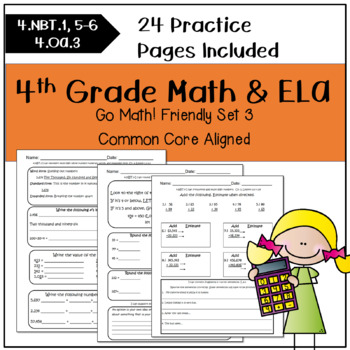Math Review Worksheets | 4th Grade | ELA Prep | Common Core | Set 3
- PDF
- Easel Activity
Also included in
- This is my entire 4th grade math and reading worksheets sets. These include all of my 4th grade math worksheets with Reading activities instilled for a mixture of practice! The best part is these can be used right alongside the Go Math! series. The sheets spiral review the ELA Common Core StandardsPrice $17.99Original Price $25.96Save $7.97
- This is the entire bundle for 4th grade math and reading worksheets along with Go Math! notebook outlines!!! This 4th grade worksheet bundle is the perfect addition to your classroom! This math and reading bundle includes worksheets for math and Reading!! These worksheets are ideal for morning work,Price $26.99Original Price $40.91Save $13.92
Description
These are a set of 4th Grade Math Review worksheets ready to print and utilize! These are the 3rd set to my 4th Grade worksheets for math and ELA. If you purchased the first two sets these will build off of what you already have. The sheets spiral review the ELA and mathematics Common Core Standards.
They are Go Math! Friendly which means they will match with your Go Math! lessons or they can be used alone. Each page has the chapter and lesson number at the top along with the "I Can" statement for that day/section with the Common Core standard abbreviations.
If you don't use Go Math! you can still use these sheets because they are Common Core connected! As each set is created, the content will grow more challenging with the ELA CC and Go Math! series.
CHECK out my Math Review Worksheet BUNDLE here!!
******************************************************************************
If you would like to get updates on NEW and CURRENT resources...
FOLLOW me on Teachers Pay Teachers!
FOLLOW the Barnett's School House BLOG!
As always, please be sure you ask any questions and download the preview before purchasing! Thank you for looking!
Barnett's School House








